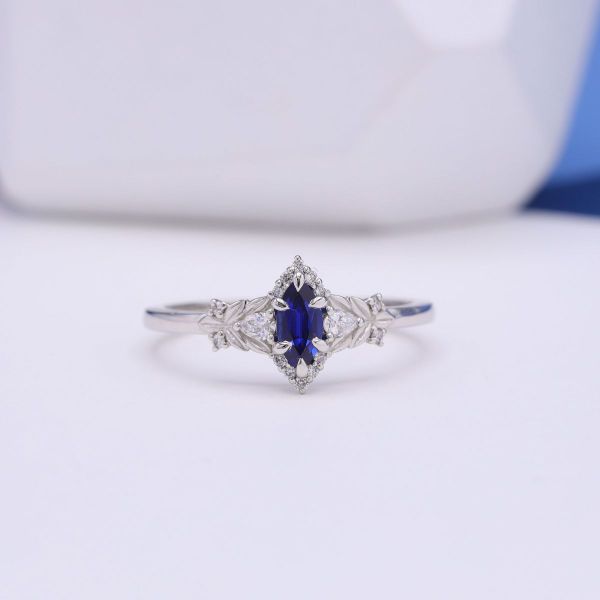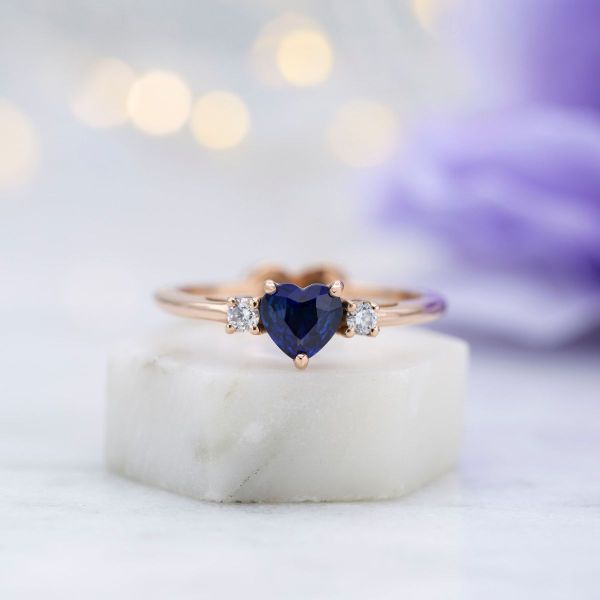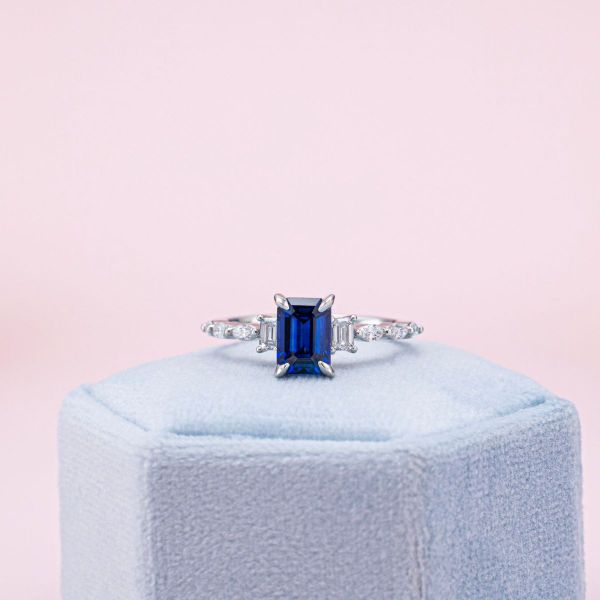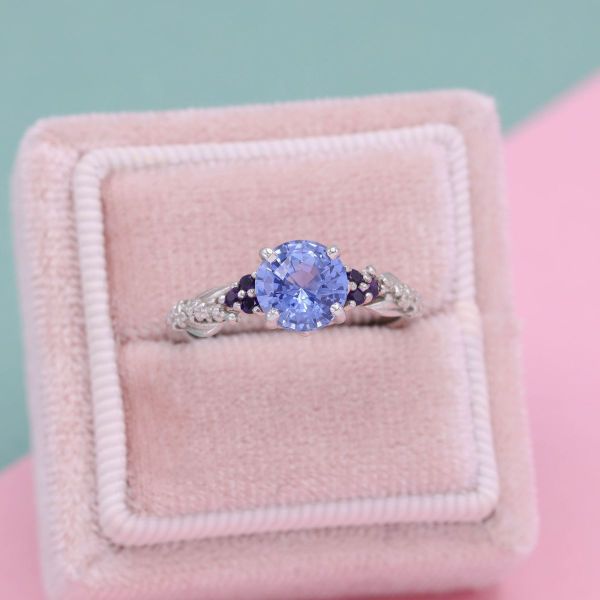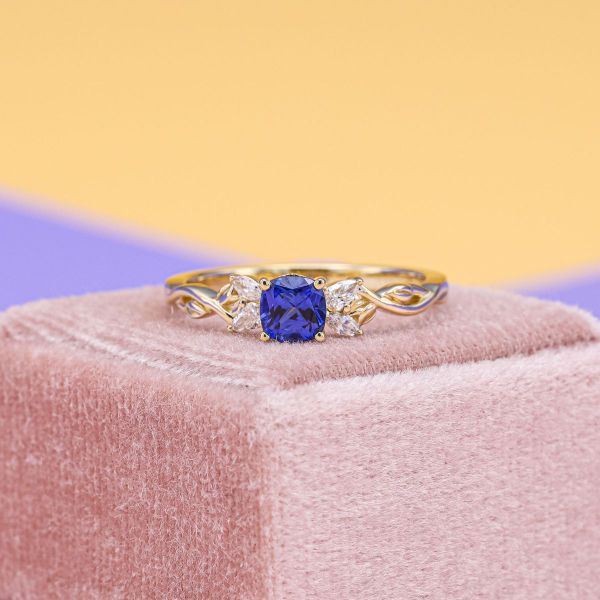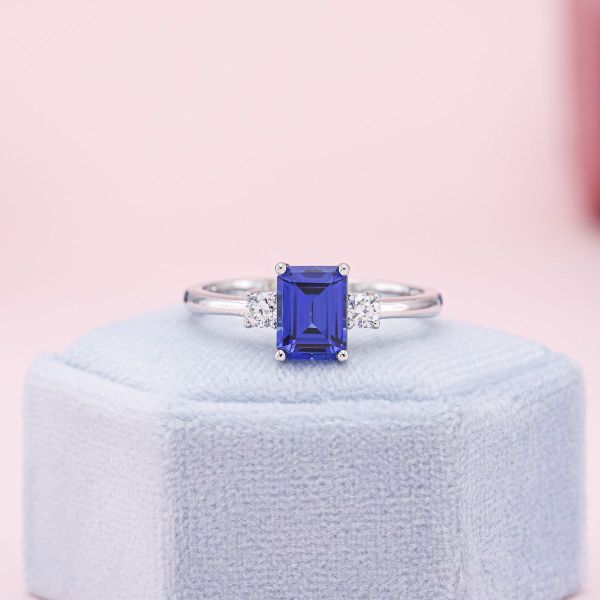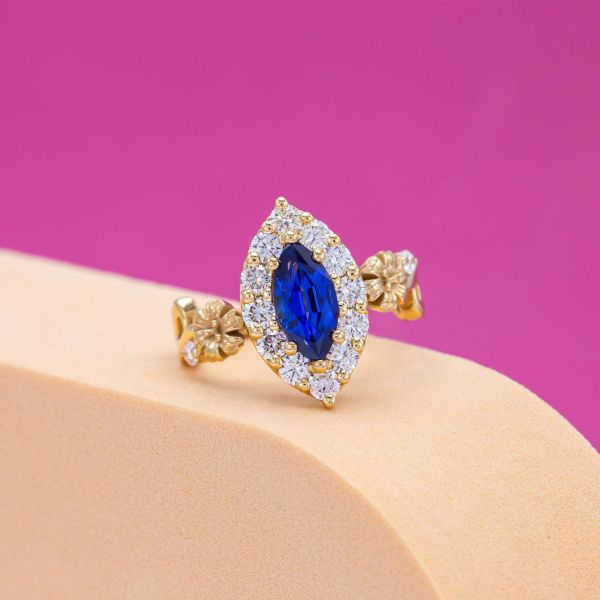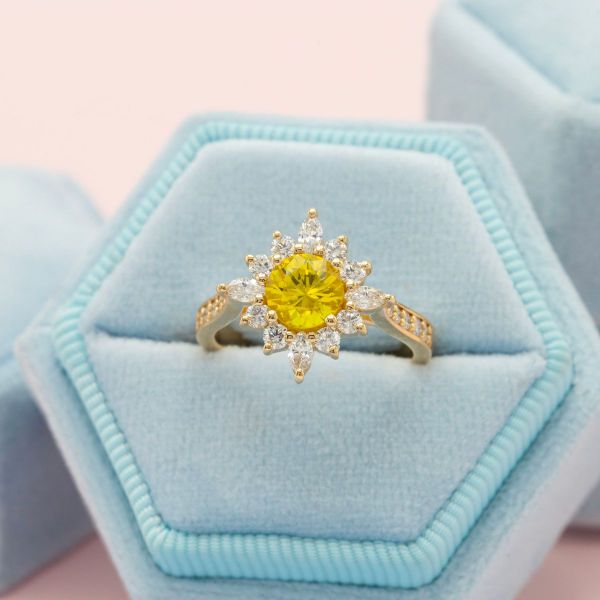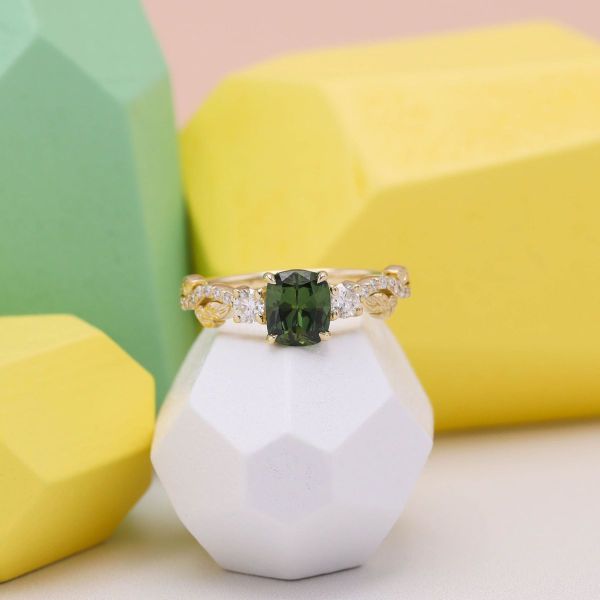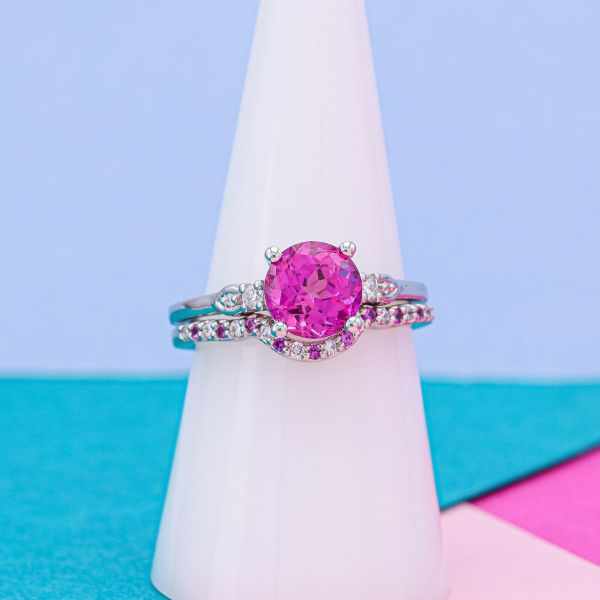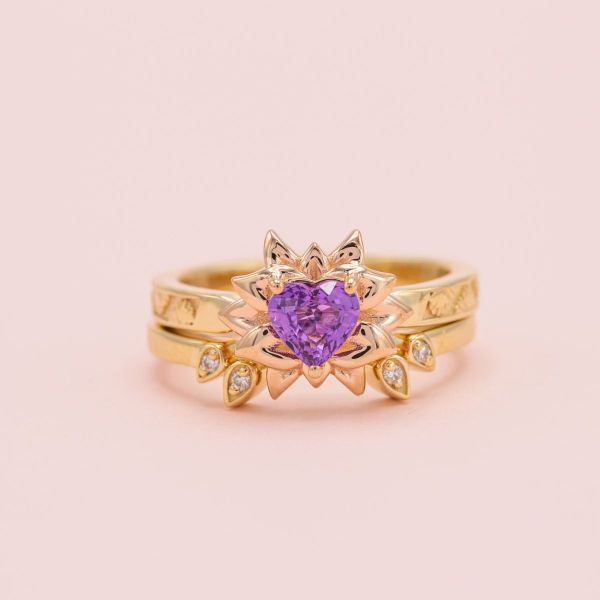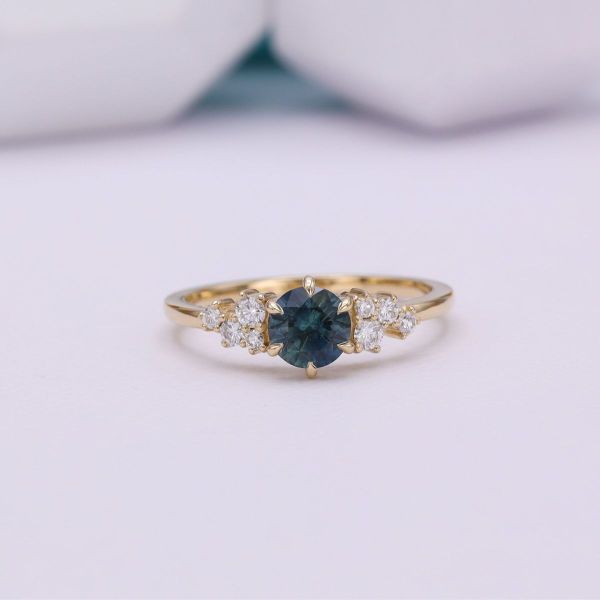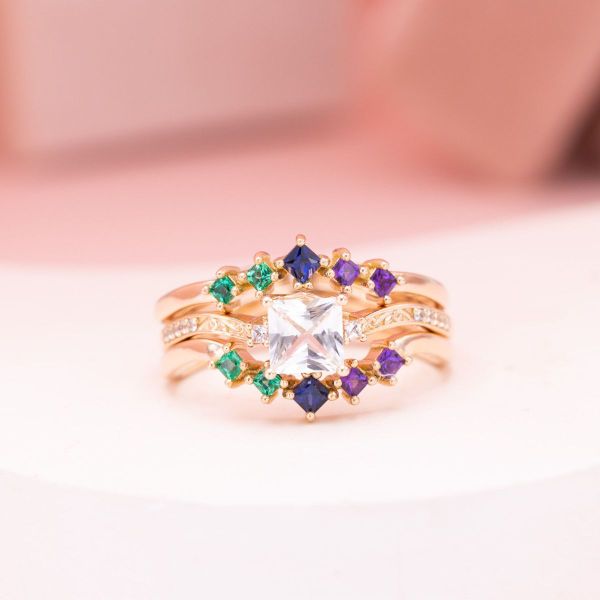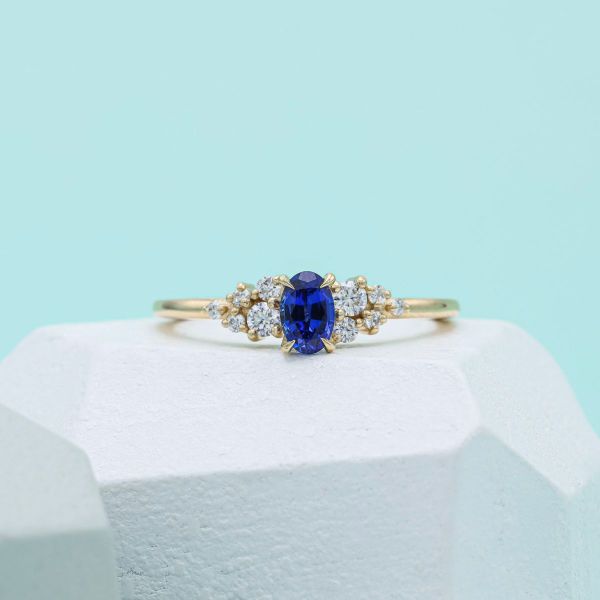Gemstone Knowledge
Lab vs. natural sapphire
What are the origin, visual, and cost differences between lab and natural sapphires?
Sapphires are a popular alternative to diamonds for engagement rings, offering anything from a splash of that classic deep blue to a more modern pink, orange, green, purple, or even yellow. If you’ve already started your sapphire shopping journey, you’ve probably come across lab sapphires as an option and are wondering how they compare to their natural counterparts. To set the record straight, lab sapphires are real sapphires, being chemically identical to the natural ones, just created faster in a lab instead of over millions of years in the earth.
That being said, experts are usually pretty good at telling the difference between the two just by looking at them. Why? Thanks to their controlled-environment origins, lab sapphires are highly standardized, always appearing in what the industry considers to be top color. For example, we offer three shades of lab-created blue sapphire, versus natural sapphires that can boast an almost infinite variety of blue hues with varying intensity. Both are 100% genuine, but it's up to you to decide between the perfection of lab or the uniqueness of natural! Let’s take a closer look at how these two types of sapphires match up in visual appeal, price, origin, and durability.
Comparing lab and natural sapphires
Origin and durability
When you think about it, the formation process of both natural and lab sapphires is inherently the same: certain minerals come together and grow into crystals when the right conditions are met (heat, time, etc.). However, where these two stones differ in their formation process is origin: one from the deep layers of the earth, and the other from a laboratory.
While corundum—the mineral name for sapphire—forms across the globe, gem quality versions come from mines in Sri Lanka, Australia, Kashmir, Myanmar, Thailand, and Montana. Natural sapphires require specific metamorphic or igneous rocks to form, and the way each works is a bit different.
Metamorphic rocks undergo high heat and pressure to form into other types of rock (like a caterpillar in a cocoon that will eventually become a butterfly), and igneous rocks form when molten rock solidifies and crystallizes (sort of like melted ice cream when you put it back in the freezer). These rocks must also contain the right ingredients for sapphires to form, requiring plenty of aluminum with absolutely no silicon present. To make classic blue sapphires, iron and titanium must also be present (who knew sapphires were such prima donnas?!).Once the rocks are super heated, they must cool slowly to form crystals which are then mined and sold as sapphires. The slower the cooling, the larger the crystals. Whew, we’re exhausted just thinking about the formation process of natural sapphires!
In contrast, lab sapphires are the result of two different possible processes: melt processes and solution processes. There are multiple types of melt processes, but they all typically involve melting aluminum oxide powder via flame fusion or radio waves to form a sapphire droplet or crystal. These processes are less expensive than other methods, and some of them can produce as much as 4” of sapphire crystal per hour!
The solution process, also known as “hydrothermal synthesis”, involves growing sapphire crystals in a solution to mimic the natural conditions of corundum formation. Basically, a seed crystal is placed in a mineral solution and subjected to intense heat and pressure, with sapphire forming around the seed in the process. There’s also the flux process, which combines a flux material (purifying agent or solvent) with the traditional ingredients for sapphires. As this mixture heats up and then cools, sapphire crystals form, which can take up to a year in some cases!
The time and effort needed to create lab sapphires pales in comparison to the millions of years needed to form natural stones, but both varieties are equally beautiful. You might be wondering, if one is formed over millions of years and the other in days, does that mean one will be more fragile than the other? The answer is, no! There’s really no difference in durability when comparing lab and natural sapphires, and both versions of this stone receive a 9 rating on the Mohs hardness scale, putting them just below diamonds at a perfect 10. This means both lab and natural sapphires are great for daily and long-term wear!
Appearance
Because they are chemically and physically the same, it can be easy to assume that natural and lab sapphires look exactly alike as well. But that’s not exactly the case! While they have identical atomic structures and behave similarly, when it comes to color variety, natural sapphires offer many more hues and saturations to choose from.
Let’s think of natural and lab sapphires as ravioli. When you make ravioli at home (natural sapphires), there's going to be some variety among them with different shapes, sizes, varied amounts of dimples, or even a filling leak (let's hope not!). Compare these homemade ravioli to the uniform ones you get from the freezer section of the grocery store (lab sapphires), where each one is a perfect little square with crimped edges. Both types of ravioli are delicious, but what you’re looking for in a pasta (oops, we mean sapphire) can impact which one you choose.
For example, take a look at these lab sapphires and compare them to the natural sapphires above. Notice anything? The color provided by the lab sapphires is seamless and standardized, coming in just one shade with one or two slight variations. In contrast, the natural blue sapphires come in a range of hues: you can find colors like pure blue, cornflower blue, violet blue, and more!
The same is true for other hues as well—lab sapphires typically provide one hue option per color, but natural sapphires come in a wider range of hues, tones, and saturations, giving couples a chance to be more particular when picking the right color for them. While lab sapphires can attain some of the lesser seen color varieties available in natural stones—even Padparadscha sapphires—they’re always going to be limited ranges of the chosen color when compared to the variety of natural sapphires. This applies to purple, pink, green, yellow, and champagne varieties as well, but natural and lab sapphires are both stunning when it comes to their colorful displays. You’ll just get many more shade options with natural stones!
What’s more, some natural sapphires do contain inclusions, setting them apart from eye-clean lab stones. Most sapphires you’ll come across are eye clean, and we do our best at CustomMade to ensure we show you quality natural sapphires and review each stone before it is presented.
Overall, if you’re looking for perfect color, you can’t beat the consistency and cost of a lab sapphire. However, if you’d prefer a sapphire with a little more personality and a lot more color options, a natural sapphire is a fantastic choice!
Cost
Another big area where lab and natural sapphires differ is cost. Because they’re made in a controlled environment in less time, lab sapphires cost less than their natural counterparts.
Prices for natural sapphires really depend on a mix of color and size. For instance, a mined 1 carat white sapphire comes in at around $200-$650, while a mined 1 carat blue sapphire with recommended color can reach prices of $1,900-$3,100. The rest of the colors fall somewhere between these two price ranges, but this gives a good picture of just how varied natural sapphire prices can be! Color definitely impacts the price of natural stones in any hue, with pure blue variations and stones with vivid saturation, lively tone, or no secondary color commanding higher prices.
You can save a few (or a few thousand) bucks with a lab version and still purchase a true sapphire! Prices for 1 carat lab sapphires of any color range from $500-600, so their cost is a little bit easier to predict. While saving money on your sapphire may be a major selling point for some couples who want standardized color, others prefer to spend a bit more to purchase a natural sapphire with a wider color variety courtesy of Mother Earth herself. The choice is entirely up to you!
Lab or natural: which sapphire will you choose?
The results are in: whether you want a sapphire from earth’s crust or one created in a lab, you’re getting the genuine article either way! Natural and lab sapphires have similar appeal and durability, and the main areas where they differ are their backstory, cost, and color. As such, if you want a sapphire with a slightly lower price point and guaranteed, high-quality color, a lab sapphire is a great option. On the other hand, if you love the idea of your sapphire forming over millions of years and don’t mind paying a bit more for something unique, a natural sapphire is an excellent choice. Whichever you choose, our team at CustomMade can walk you through various stones and help you find the right one for your engagement ring.
About CustomMade
CustomMade designs and creates one-of-a-kind, custom engagement rings and fine jewelry. Each piece we create is inspired by you, designed for you, and made just for you.
